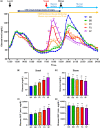Effects of intake of four types of snack with different timings on postprandial glucose levels after dinner
- PMID: 37061585
- PMCID: PMC10349787
- DOI: 10.1007/s00394-023-03138-4
Effects of intake of four types of snack with different timings on postprandial glucose levels after dinner
Abstract
Purpose: It has been reported that the consumption of fruit granola (FG), mulberry leaves, and barley cookies as an afternoon snack suppresses the postprandial increase in glucose levels at dinner. However, there have been no reports on the second-meal effect of snacking on popular snacks, such as potato chips (PC), roasted sweet potato (SP), and black beans (BB), or on the interval between snacking and dinner.
Method: The present study was an open-label randomized crossover trial of five study groups (PC, SP, BB, FG, and no snack) regarding the second-meal effects with different intervals between snacks and dinner. The subjects consumed prescribed meals for lunch and dinner at 12:00 and 19:00, and a snack fixed at 838 kJ (= 200 kcal) at 15:00 or 17:00.
Results: When the participants snacked at 15:00, the postprandial glucose elevation at dinner was suppressed in the FG and SP groups, and the area under the curve (AUC) was also low. When they snacked at 17:00, the postprandial glucose elevation was suppressed in all the groups. The AUCs for PC, FG, and SP were lower than those for no snacking. On the other hand, carbohydrate intake increased with snacking, but the total AUC of snacks and dinner did not differ in any of the groups. The duration of hyperglycemia decreased with snack intake, as did the glucose amplitude.
Conclusion: We believe that the intake of carbohydrates and soluble fiber in snacks is an important factor in the second-meal effect at dinner. These results will contribute to the development of snacking and research into the second-meal effect.
Keywords: Black bean; Glucose; Granola; Potato chips; Second-meal effect; Snack; Sweet potato.
© 2023. The Author(s).
Conflict of interest statement
HM and KI are employees of Calbee, Inc. YM, KH, SS, and AF report no conflicts of interest in this work.
Figures







Similar articles
-
Consumption of Biscuits with a Beverage of Mulberry or Barley Leaves in the Afternoon Prevents Dinner-Induced High, but Not Low, Increases in Blood Glucose among Young Adults.Nutrients. 2020 May 28;12(6):1580. doi: 10.3390/nu12061580. Nutrients. 2020. PMID: 32481557 Free PMC article. Clinical Trial.
-
40-year trends in meal and snack eating behaviors of American adults.J Acad Nutr Diet. 2015 Jan;115(1):50-63. doi: 10.1016/j.jand.2014.06.354. Epub 2014 Aug 1. J Acad Nutr Diet. 2015. PMID: 25088521 Free PMC article.
-
An Afternoon Hummus Snack Affects Diet Quality, Appetite, and Glycemic Control in Healthy Adults.J Nutr. 2020 Aug 1;150(8):2214-2222. doi: 10.1093/jn/nxaa139. J Nutr. 2020. PMID: 32488233 Free PMC article. Clinical Trial.
-
What Is a Snack, Why Do We Snack, and How Can We Choose Better Snacks? A Review of the Definitions of Snacking, Motivations to Snack, Contributions to Dietary Intake, and Recommendations for Improvement.Adv Nutr. 2016 May 16;7(3):466-75. doi: 10.3945/an.115.009571. Print 2016 May. Adv Nutr. 2016. PMID: 27184274 Free PMC article. Review.
-
The role of snacking in energy balance: a biobehavioral approach.J Nutr. 2011 Jan;141(1):158-62. doi: 10.3945/jn.109.114330. Epub 2010 Dec 1. J Nutr. 2011. PMID: 21123465 Review.
Cited by
-
Postprandial Glucose Response in Type 2 Diabetes Mellitus Patients and Possible Antioxidant Properties of a Plant-Based Snack Bar.Foods. 2024 Dec 20;13(24):4123. doi: 10.3390/foods13244123. Foods. 2024. PMID: 39767064 Free PMC article.
-
Timing and Nutrient Type of Isocaloric Snacks Impacted Postprandial Glycemic and Insulinemic Responses of the Subsequent Meal in Healthy Subjects.Nutrients. 2024 Feb 14;16(4):535. doi: 10.3390/nu16040535. Nutrients. 2024. PMID: 38398859 Free PMC article.
References
-
- Kajiyama S, Imai S, Hashimoto Y, Yamane C, Miyawaki T, Matsumoto S, Ozasa N, Tanaka M, Kajiyama S, Fukui M. Divided consumption of late-night-dinner improves glucose excursions in young healthy women: a randomized cross-over clinical trial. Diabetes Res Clin Pract. 2018;136:78–84. doi: 10.1016/j.diabres.2017.11.033. - DOI - PubMed
-
- Imai S, Kajiyama S, Hashimoto Y, Nitta A, Miyawaki T, Matsumoto S, Ozasa N, Tanaka M, Kajiyama S, Fukui M. Consuming snacks mid-afternoon compared with just after lunch improves mean amplitude of glycaemic excursions in patients with type 2 diabetes: A randomized crossover clinical trial. Diabetes Metab. 2018;44(6):482–487. doi: 10.1016/j.diabet.2018.07.001. - DOI - PubMed
Publication types
MeSH terms
Substances
LinkOut - more resources
Full Text Sources

